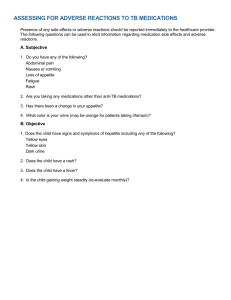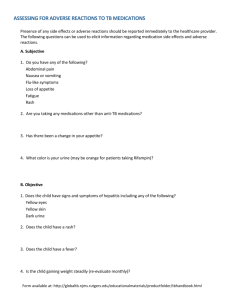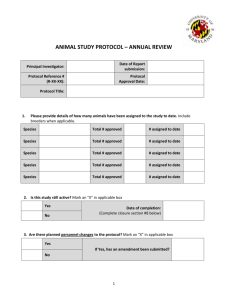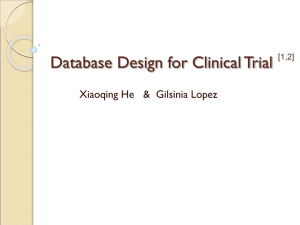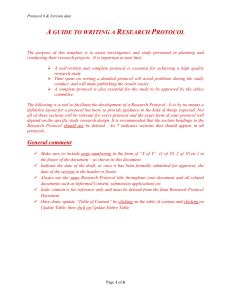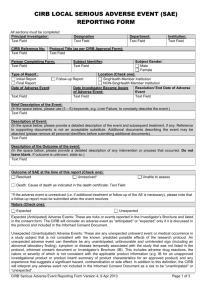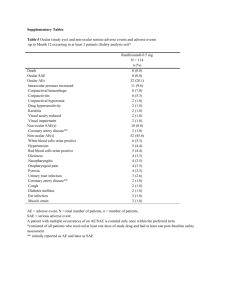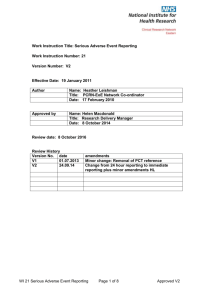AE-long
advertisement
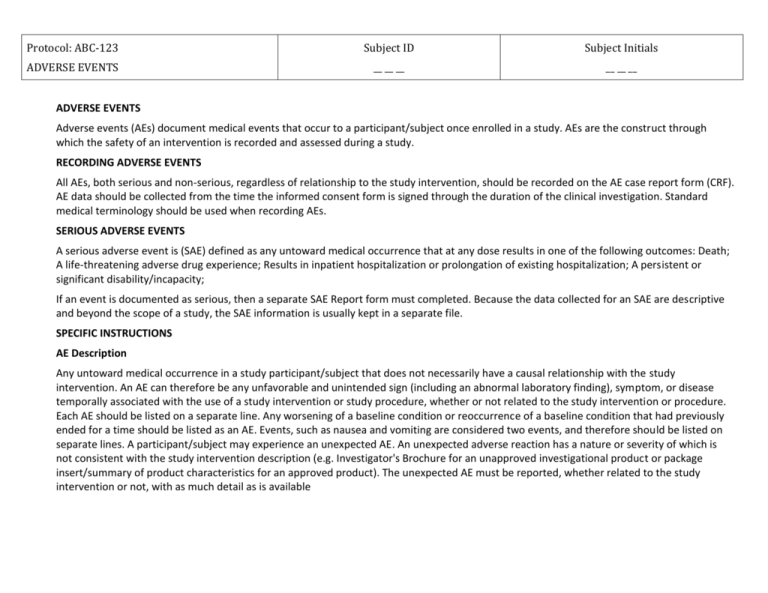
Protocol: ABC-123 Subject ID Subject Initials ADVERSE EVENTS __ __ __ __ __ __ ADVERSE EVENTS Adverse events (AEs) document medical events that occur to a participant/subject once enrolled in a study. AEs are the construct through which the safety of an intervention is recorded and assessed during a study. RECORDING ADVERSE EVENTS All AEs, both serious and non-serious, regardless of relationship to the study intervention, should be recorded on the AE case report form (CRF). AE data should be collected from the time the informed consent form is signed through the duration of the clinical investigation. Standard medical terminology should be used when recording AEs. SERIOUS ADVERSE EVENTS A serious adverse event is (SAE) defined as any untoward medical occurrence that at any dose results in one of the following outcomes: Death; A life-threatening adverse drug experience; Results in inpatient hospitalization or prolongation of existing hospitalization; A persistent or significant disability/incapacity; If an event is documented as serious, then a separate SAE Report form must completed. Because the data collected for an SAE are descriptive and beyond the scope of a study, the SAE information is usually kept in a separate file. SPECIFIC INSTRUCTIONS AE Description Any untoward medical occurrence in a study participant/subject that does not necessarily have a causal relationship with the study intervention. An AE can therefore be any unfavorable and unintended sign (including an abnormal laboratory finding), symptom, or disease temporally associated with the use of a study intervention or study procedure, whether or not related to the study intervention or procedure. Each AE should be listed on a separate line. Any worsening of a baseline condition or reoccurrence of a baseline condition that had previously ended for a time should be listed as an AE. Events, such as nausea and vomiting are considered two events, and therefore should be listed on separate lines. A participant/subject may experience an unexpected AE. An unexpected adverse reaction has a nature or severity of which is not consistent with the study intervention description (e.g. Investigator's Brochure for an unapproved investigational product or package insert/summary of product characteristics for an approved product). The unexpected AE must be reported, whether related to the study intervention or not, with as much detail as is available Protocol: ABC-123 Subject ID Subject Initials ADVERSE EVENTS __ __ __ __ __ __ Start Date Record the date the adverse event started. The date should be recorded to the level of granularity known (e.g., year, year and month, complete date) and in the specified format. If a previously recorded AE worsens, a new record should be created with a new start date. There should be no AE start date prior to the date of the informed consent. Any AE that started prior to the informed consent date belongs instead in the medical history. If an item recorded on the medical history worsens during the study, the date of the worsening is entered as an AE with the start date as the date the condition worsened. End Date Record the date the adverse event stopped or worsened. The date should be recorded to the level of granularity known (e.g., year, year and month, complete date) and in the specified format. If an AE worsens, record an end date and create a new AE record with a new start date and severity. Severity Choose the one severity that best describes the investigator’s assessment of the intensity of the AE. Severe events interrupt the participant’s/subject’s normal daily activities and generally require systemic drug therapy or other treatment; they are usually incapacitating. Consequently, a change in severity may constitute a new reportable AE. Severity is not synonymous with seriousness. A severe rash is not likely to be an SAE. Likewise, a severe headache is not necessarily an SAE. However, mild chest pain may result in a day’s hospitalization and thus is an SAE. Relatedness Choose one. Record the investigator’s assessment of the degree of “relatedness” of the AE to the study intervention. . Action Taken with Study Intervention Choose one. Other Action Taken Choose either Yes or No. If treatment was required, then the corresponding treatment needs to be recorded on the Concomitant Medications CRF. Protocol: ABC-123 Subject ID Subject Initials ADVERSE EVENTS __ __ __ __ __ __ Outcome Choose one. The outcome of an AE may not be captured at the visit during which it was first reported, but must be captured to provide a complete picture of the event. Entering the outcome of an AE may be deferred until the AE is resolved, or the participant/subject completes the study. For AEs that have not resolved at the time of a study visit, the outcome should be marked as “unresolved” on the AE case report form. Serious Choose either Yes or No. This question should only be answered YES if the outcome of the AE results in at least one of the following: death; a life-threatening adverse drug experience; results in inpatient hospitalization or prolongation of existing hospitalization; a persistent or significant disability/incapacity; or a congenital anomaly/birth defect. If an AE is serious, this provides a trigger that additional information must be provided by the site investigator. The site investigator then completes a Serious Adverse Event (SAE) form. Additionally, the site institution and/or IRB may also have an SAE form and procedures for reporting SAEs. Protocol: ABC-123 Subject ID Subject Initials ADVERSE EVENTS __ __ __ __ __ __ Adverse Event Description Start Date [YYYY/MM/DD] 1. Severity Relationship to Study Treatment Action Taken with study intervention Other Action Taken Outcome Serious? Mild Unrelated None Yes Recovered/Resolved Yes* Moderate Unlikely Recovered/Resolved With Sequelae No Probable Study Intervention Interrupted No Severe Life-threatening or Disabling Possible Definite Fatal/Death Study Intervention Discontinued End Date [YYYY/MM/DD] Recovering / Resolving Unresolved / Not Recovered Study Intervention Modified Fatal Unknown 2. Mild Unrelated None Yes Recovered/Resolved Yes* Moderate Unlikely No Probable Recovered/Resolved With Sequelae No Severe Study Intervention Interrupted Life-threatening or Disabling Possible Definite Fatal/Death Study Intervention Discontinued Recovering / Resolving Unresolved / Not Recovered Study Intervention Modified Fatal Unknown 3. Mild Unrelated None Yes Recovered/Resolved Yes* Moderate Unlikely Recovered/Resolved With Sequelae No Probable Study Intervention Interrupted No Severe Life-threatening or Disabling Possible Definite Fatal/Death Study Intervention Discontinued Study Intervention Modified Recovering / Resolving Unresolved / Not Recovered Fatal Unknown * Yes should be answered when the adverse event results in death, is life-threatening, requires in-patient hospitalization or prolongation of existing hospitalization, results in persistent or significant disability/incapacity, or is a congenital anomaly/birth defect. ____________________________________________________________________ Principal Investigator Signature __ __ __ __/__ __ __/__ __ Date [YYYY/MM/DD]
